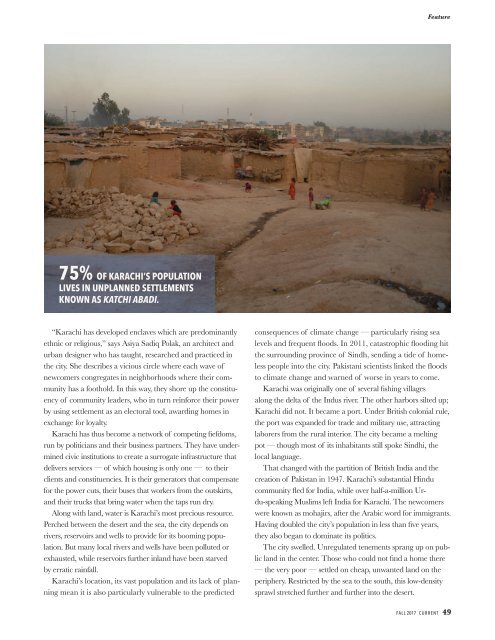Current Magazine
Create successful ePaper yourself
Turn your PDF publications into a flip-book with our unique Google optimized e-Paper software.
Feature<br />
75% OF KARACHI’S POPULATION<br />
LIVES IN UNPLANNED SETTLEMENTS<br />
KNOWN AS KATCHI ABADI.<br />
“Karachi has developed enclaves which are predominantly<br />
ethnic or religious,” says Asiya Sadiq Polak, an architect and<br />
urban designer who has taught, researched and practiced in<br />
the city. She describes a vicious circle where each wave of<br />
newcomers congregates in neighborhoods where their community<br />
has a foothold. In this way, they shore up the constituency<br />
of community leaders, who in turn reinforce their power<br />
by using settlement as an electoral tool, awarding homes in<br />
exchange for loyalty.<br />
Karachi has thus become a network of competing fiefdoms,<br />
run by politicians and their business partners. They have undermined<br />
civic institutions to create a surrogate infrastructure that<br />
delivers services — of which housing is only one — to their<br />
clients and constituencies. It is their generators that compensate<br />
for the power cuts, their buses that workers from the outskirts,<br />
and their trucks that bring water when the taps run dry.<br />
Along with land, water is Karachi’s most precious resource.<br />
Perched between the desert and the sea, the city depends on<br />
rivers, reservoirs and wells to provide for its booming population.<br />
But many local rivers and wells have been polluted or<br />
exhausted, while reservoirs further inland have been starved<br />
by erratic rainfall.<br />
Karachi’s location, its vast population and its lack of planning<br />
mean it is also particularly vulnerable to the predicted<br />
consequences of climate change — particularly rising sea<br />
levels and frequent floods. In 2011, catastrophic flooding hit<br />
the surrounding province of Sindh, sending a tide of homeless<br />
people into the city. Pakistani scientists linked the floods<br />
to climate change and warned of worse in years to come.<br />
Karachi was originally one of several fishing villages<br />
along the delta of the Indus river. The other harbors silted up;<br />
Karachi did not. It became a port. Under British colonial rule,<br />
the port was expanded for trade and military use, attracting<br />
laborers from the rural interior. The city became a melting<br />
pot — though most of its inhabitants still spoke Sindhi, the<br />
local language.<br />
That changed with the partition of British India and the<br />
creation of Pakistan in 1947. Karachi’s substantial Hindu<br />
community fled for India, while over half-a-million Urdu-speaking<br />
Muslims left India for Karachi. The newcomers<br />
were known as mohajirs, after the Arabic word for immigrants.<br />
Having doubled the city’s population in less than five years,<br />
they also began to dominate its politics.<br />
The city swelled. Unregulated tenements sprang up on public<br />
land in the center. Those who could not find a home there<br />
— the very poor — settled on cheap, unwanted land on the<br />
periphery. Restricted by the sea to the south, this low-density<br />
sprawl stretched further and further into the desert.<br />
FALL 2017 CURRENT 49





